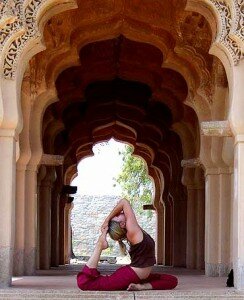* Guest Post by *
What – on earth – is an Ashtangi?
I once was called an “Ashtangi” by someone in the studio. The word was said with a bitter negative tone, like a curse. I was taken aback! What kind of misunderstanding and confusion existed that another yogi would use this label in such a way? How have we all missed the mark by so wide a margin if some people believe there is such a divide between Ashtanga and other practices?
I have since come to realizes that there exists a great deal of misunderstanding, erroneous belief, and even fear about Ashtanga yoga.
Accessability of the Practice
Many people deem Ashtanga yoga to be inaccessible to them. Many of the postures look too difficult and the vinyasa and some postures appear to require so much strength. As a result, these people do not give it the try that the practice deserves.
It is true that Ashtanga can involve strength, but this is one of the benefits that is gained as one develops their Ashtanga. It is not a requirement to start. Furthermore, beginners are not (should never be) expected to complete the series or even approach the series the way a 2 or 3 year practitioner might. The “Mysore” style of teaching allows every student at every level to get whatever attention they need to develop their practice. It assures accessibility of the practice for all. However, the majority of North American studios are not structured in a way to support the Mysore teaching style. This is unfortunate since “lead series” classes contribute to the appearance of Ashtanga being intimidating, and thus the lead classes can sometimes make the practice less accessible.
Benefits
Ashtanga is a most potent practice that, when practiced regularly, will transform the whole person (physically, mentally, spiritually) faster than any other practice I know. In addition to strength and flexibility, when practiced as intended, Ashtanga will also purify the body through detoxification, increase balance, vitality, focus of the mind, and openness of heart. That may sound like a lot of promises from a practice that appears to be about strength and movement. But in reality the deeper practice is what Ashtanga yoga is all about. It is in the correct unification of breath with movement, of finding the bandas (energy gates) in the body and the form and direction the gaze (drishti) that energy is released from the base of the spine and elevated up the spine and out into the nadis (energy channels) in the body. The mind then becomes more focused and stilled in this process. The 8 limbs of yoga (as described by Patanjali) are all built into the Ashtanga practice – some obviously (Asana and Pranayama) and some subtly and unannounced. Arguably, Dhyana and Samadhi are not so much built into the practice as they are the ripened fruit of continuous practice.
Taking Flight
The deeper and wider the roots of a tree grow the higher it can quietly reach into the sky. So it is with Ashtanga. One of the more subtle but powerful aspects of the practice is the development of a deep rootedness to earth in all the poses. Yoga is the joining of heaven and earth. When the flesh meets earth and roots down, when the root chakra is energetically connected deeply to earth and up into the spine, then the yogi can lift up into heaven with confidence and fluidity: She takes flight!
Work
There is no escaping the fact that you will not learn the primary series of Ashtanga in one class, one week, or one month of classes. To a world bent upon instant gratification, Ashtanga is not all that attractive. Like anything in life that truly is worthwhile, it takes effort and dedication. It is called a practice because it requires practice (I have never heard a yogi say “I do the Ashtanga skill”!) As our lives continually change and flow, the practice adjusts with us. It is as portable as your pants through place and time!
Yang and Yin
Ashtanga is typically pointed to as an example of a Yang practice. This is reasonable as the practice has all the characteristics of “Yang”: heat generation, upward outward movement involving strength and action etc. However, like the Yin/Yang symbol, there is always a centre, that circle of Yin in the Yang as well as the centre of Yang in the Yin. And just like this symbol, as Yang as the Ashtanga practice may be, it is the Yin at the centre that gives the practice its grace and unleashes its benefits and power. It is in the internal gentleness and subtlety, the skillful and practiced use of drishti, bandas and breath that gradually develop and effortlessness and mindfulness in the practice. The real power of the practice is to be found in the softness and gentleness within the practitioner and from here real flow happens- like a river, like the wind.
There are many yogic paths to walk or rivers to sail toward the great ocean of Samadhi. Each of these is a route to the opening and unfolding of the person to realities that otherwise are beyond our ability to sense or know. Each is time tested. Enjoy your search for the path or river that suits you best, honouring and respecting all the paths as you explore.
Blessings upon you and your Journey
Chris B-H


You wrote, “Ashtanga is a most potent practice that, when practiced regularly, will transform the whole person (physically, mentally, spiritually) faster than any other practice I know.”
Do you teach Ashtanga?
Yes we do!